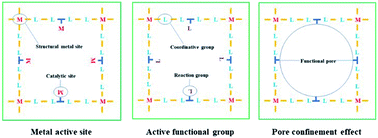Research progress in photo/electrocatalytic reduction of CO2 by functionalized metal–organic frameworks
Abstract
Environmental pollution and energy shortage caused by climate change are the most serious non-traditional security problems facing the world today, seriously threatening the survival and development of human society. As a major greenhouse gas, carbon dioxide (CO2) is an important factor leading to global climate change. It is worth noting that carbon dioxide is also an important C1 resource. Using catalytic conversion technology to efficiently and selectively convert CO2 into high value-added chemicals and fuels under mild conditions is of great significance for mitigating the adverse effects of CO2 on climate change and alleviating the energy crisis. As an emerging class of porous crystalline materials, metal–organic frameworks (MOFs) are excellent multiphase catalysts with the properties of both separable recycling of multiphase catalysts and high selectivity and activity of homogeneous catalysts. This study focuses on the structural properties of functionalized MOF catalysts and their applications in catalytic conversion of CO2, highlights recent research progress in this field, and provides an outlook on the future research trends and application prospects in this field.



 Please wait while we load your content...
Please wait while we load your content...